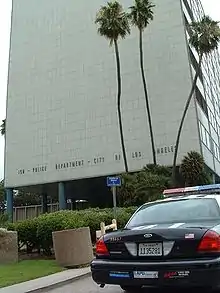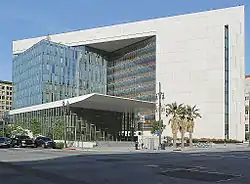Parker Center
Parker Center was the headquarters for the Los Angeles Police Department from 1955 until October 2009 and was located in downtown LA at 150 N. Los Angeles Street. It replaced buildings of the city’s 19th-century downtown. The site is to become the new “Los Angeles Street Civic Building” (LASCB), part of a larger project to diversify, revitalize and reconnect the district.[1]

Often called "The Glass House", the building was named for former LAPD chief William H. Parker. Originally called the Police Administration Building (PAB) (or Police Facilities Building),[2] groundbreaking for the center began on December 30, 1952, and construction was completed in 1955. The architect was Welton Becket and Associates and J.E. Stanton, associated architect. Maynard Woodard was director of design and Francis Runcy was the project architect. The eight-story building was of reinforced concrete with aluminum sash windows covered by louvers. Ceramic tile by Gladding, McBean covered the west elevation.[3] The building combined police facilities that had been located throughout the Civic Center area. The new building was called "Ultramodern in all respects" and "The Jail that Modern Science Built" by Popular Mechanics in 1956. The jail area was built without window bars, utilizing nonbreakable tempered glass, and Neoprene floors to reduce self-injuries. A special control board in the lineup room could simulate different lighting conditions and a wire screen that acted like a one-way mirror. The Statistical Unit was the first police department to install IBM computer equipment. The laboratories of the Scientific Investigation Division took up the entire 4th floor and included early versions of a breath-based alcohol impairment test.[4] Two prominent artworks were commissioned for the building, a large bronze modernist sculpture by Bernard Rosenthal mounted at the entrance titled "The American Family," and a mosaic work in the lobby depicting architectural landmarks of Los Angeles by Joseph Young. The mural, mounted a few feet off the ground, was 6' high and 36' long, was Young's first public work. American Artist magazine called it “Six tons of steel, copper, aluminum and glass, fused into a monolithic mosaic panel of beauty and permanence that seems to float on air.” Both artworks were removed by the Los Angeles Police Department in 2018.[5][6][7]
The location was previously home to the Olympic Hotel.[8]
On July 16, 1966, Parker suffered a fatal heart attack. Soon afterward, the Los Angeles City Council renamed the building "Parker Center". The building was one of the sites of unrest during the 1992 Los Angeles riots that followed a not-guilty verdict for the four police officers involved in the Rodney King incident.
New headquarters

With time, the Parker Center became outdated and was in need of expensive seismic retrofits. After considering a number of downtown sites for a new facility, the city council selected a property directly south of City Hall, Caltrans' former Los Angeles headquarters. Ground was broken for the new building in January 2007, which was dedicated on October 24, 2009.
Both the Old Parker Center and the new headquarters have heliports. The Old Parker Center heliport is marked with a number "5", while the new center is inscribed with an "H".
The LAPD Robbery and Homicide Division still operated from an annex of the Old Parker Center.
On January 15, 2013, the City of Los Angeles permanently closed Parker Center.[9] In 2014 the City Department of Public Works and the Bureau of Engineering recommended razing the now vacant Parker Center in favor of building a 27-story tower in its place. The razing would proceed on a floor-by-floor process, eliminating the need for wrecking balls or dynamiting. Construction of the new building would start in 2016 and last 18–24 months, with completion anticipated in 2018.[10]
2015 efforts to save Parker Center
On January 29, 2015, a city panel, The Cultural Heritage Commission, nominated Parker Center for historical status.[11][12] A tentative date for the ruling was set for April 28, 2015.[13] However, the ruling was postponed until May 5, 2015.[14] During the council meeting held on May 5, 2015, the council claimed to have "lost jurisdiction over this item" due to a technical error and did not act in time (within a 105-day time limit).[15] Committee chairman and 14th District Councilman José Huizar also presented a new motion, recommending against the razing of the building, instead preserving it and "build[ing] an adjacent tower taller than the one analyzed in the project's already complete environmental impact report".[16] Following these developments, a group of civic leaders and land-use experts convened in May 2015 to discuss the future of Parker Center. They considered whether the former City of LA police headquarters should be preserved, with some of the panel members suggesting that parts of the Parker Center could be preserved while other sections could be razed.[17]
In August 2015, it was reported that the discussions regarding the Parker Center had expanded and now revolved not just the future of the building itself, but also what should be done with surrounding areas and the district on a whole. This suggested the possibility of an alternative location for the proposed office space buildings intended to be erected on the plot currently inhabited by the Parker Center.[18][19] Three options were considered for the Parker Center.
- Updating the 319,000-square-foot edifice with improvements including seismic retrofitting and expanding the parking garage to provide another 137 spaces.
- Rehabbing some of the building while tearing down the dilapidated Parker Center jail while creating more than 522,000 square feet of usable space.
- Razing the building and replacing it with either one or two office structures with a total of about 750,000 square feet of space and 1,173 parking spaces.[20][21]
Demolition
In August 2016, the Parker Center building was threatened by demolition once again. A report from the Bureau of Engineering revealed a proposal to build a new municipal office building on the existing site of Parker Center.[22][23] Given the threat of demolition, the Cultural Heritage Commission quickly mobilized another attempt the following month to award the Parker Center with a landmark status, after having failed to meet the deadline to do so during the preceding year.[24]
However, in December 2016 the city Bureau of Engineering once again recommended razing the building, saying that tearing down the structure and creating the new high-rise would cost $514 million. The city Bureau of Engineering claimed that the preservation and smaller new edifice option would cost $621 million (both plans would have roughly the same amount of office space). The city Bureau of Engineering's timetable suggested securing approvals by February 2017.[25][26]
The Los Angeles City Council, on March 24, 2017, voted unanimously to approve a proposal to demolish Parker Center, and replace it with an office tower that would consolidate offices of city employees.[27] {{cns|date=January 2021|The above ground demolition of Parker Center was completed on July 15, 2019.
In popular culture
Parker Center appears in many episodes of the television drama Dragnet, beginning with the fifth season in 1955. It also appears in several establishing shots for the Perry Mason TV series between 1958 and 1966. It appeared in several episodes (seasons 3, 4 & 10) of Columbo. The NBC drama Hunter also used the Parker Center in the sixth and seventh seasons. Parker Center is also the location of the Priority Homicide Division, and later, Major Crimes on the television series The Closer.
The building is also featured as one of the main locations in Police Quest: Open Season, the fourth installment of the Police Quest series, a 1993 PC video game by Sierra Entertainment.
Parker Center was also featured in the 1970-set 2014 film Inherent Vice.
Parker Center is often mentioned in the novels of the Harry Bosch series written by Michael Connelly and the Shane Scully series written by Stephen J. Cannell. Parker Center and its closure is also mentioned in the Joseph Wambaugh novel Hollywood Hills.
Parker Center also appears in the 1983 movie Blue Thunder.
References
- https://civiccenterprojects.lacity.org/sites/default/files/CCD%20191119%20Community%20Mtg%20%234%20Presentation_sm.pdf
- Austin, Paige (27 April 2015). "Should the Parker Center Be Preserved as an Historic Landmark?". North Hollywood-Toluca Lake, CA Patch. Retrieved 6 May 2015.
- Entenza, John (7 August 2020). "Police Facility Building by Welton Becket and Associates, Architects" (PDF). Arts & Architecture July 1956 via usmodernist.org. Los Angeles.
- Kemmerer, Jack (7 August 2020). "The Jail That Modern Science Built". Popular Mechanics, Google Books. Los Angeles.
- Los Angeles Downtown News (7 August 2020). "Prominent Mural Removed From Parker Center". Los Angeles Downtown News. Los Angeles.
- Noland, Claire (7 August 2020). "Joseph Young, 87;his murals, sculptures adorn the Southland". Los Angeles Times. Los Angeles.
- Entenza, John (7 August 2020). "Police Facility Building by Welton Becket and Associates, Architects" (PDF). Arts & Architecture July 1956 via usmodernist.org. Los Angeles.
- Nakagawa, Martha (11 June 2008). "Little Tokyo's Bronze Age". Discover Nikkei. Los Angeles.
- Villacorte, Christina (14 January 2013). "End of an era: LAPD closes Parker Center, iconic headquarters". Los Angeles Daily News.
- Evans, Donna (May 1, 2014). "City Recommends Replacing Parker Center With 27-Story Tower". Los Angeles Downtown News. Retrieved 17 May 2015.
- Schreiber, John (January 29, 2015). "LAPD's old Parker Center headquarters could get historical status". MyNewsLA.com. Retrieved January 31, 2015.
- The Times Editorial Board (January 30, 2015). "Commission Nominates Parker Center for Historical Status". Los Angeles Downtown News. Retrieved January 31, 2015.
- "Raze or rehabilitate Parker Center? City must make a decision soon". Los Angeles Times. 17 April 2015. Retrieved 18 April 2015.
- Sklar, Debbie L. (28 April 2015). "Could former LAPD HQ be designated a historic landmark?". MyNewsLA.com. Retrieved 2 May 2015.
- "Planning and Land Use Management Committee - May 5th, 2015 (audio recording)". Granicus. City of Los Angeles. Retrieved 6 May 2015.
- Kim, Eddie (7 May 2015). "City Blows Parker Center Deadline, But Wrecking Ball Still Isn't Coming". Los Angeles Downtown News. Retrieved 18 May 2015.
- "Parker Center's Possible Demolition Sparks Interest in LA's Civic Center Master Plan". The Planning Report.
- "Parker Center, the L.A. Mall and the Future of the Civic Center". Los Angeles Downtown News.
- Barragan, Bianca (August 11, 2015). "Los Angeles is Thinking About Making its Civic Center Into a Real Neighborhood". Curbed LA.
- "City Examines Three Options for Empty Parker Center". Ladowntownnews.com. 2013-09-03. Retrieved 2016-04-28.
- Regardie, Jon (September 3, 2013). "Los Angeles Street Civic Building/ Demolition of Parker Center Project". City of Los Angeles, Bureau of Engineering. Retrieved April 6, 2020.
- "Parker Center Site: Environmental Impact Report" (PDF). Los Angeles Bureau of Engineering.
- Sharp, Steven (September 13, 2016). "Imagining the Future of Parker Center". Urbanize Los Angeles.
- Chiland, Elijah (September 8, 2016). "The Parker Center, LAPD's historic headquarters, threatened by demolition yet again". Curbed Los Angeles.
- Kim, Eddie (December 16, 2016). "City Recommends Razing Parker Center, Again". Los Angeles Downtown News.
- Miranda, Carolina A. (December 19, 2016). "Roundup: Sylvester Stallone and NEA, art and Inauguration Day, future of Parker Center". Los Angeles Times.
- cite news| title=L.A. City Council backs plan to knock down Parker Center, build office tower| url=https://www.latimes.com/local/lanow/la-me-ln-parker-center-vote-20170324-story.html%7C first=Dakota| last=Smith| date=March 24, 2017| newspaper=Los Angeles Times| accessdate=April 6, 2020| url-access=subscription}}
External links
| Wikimedia Commons has media related to Parker Center (Los Angeles). |
